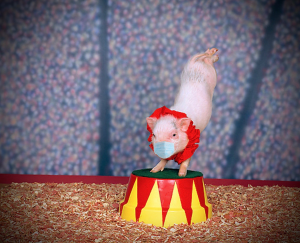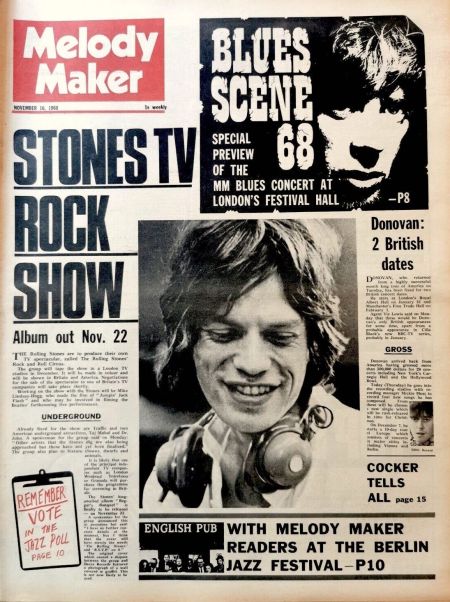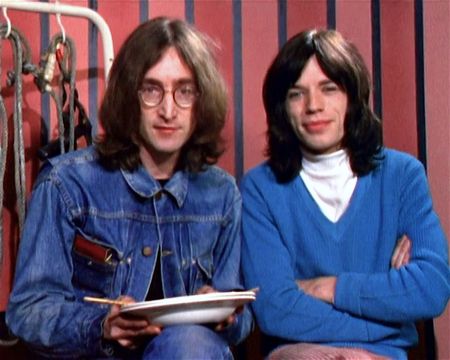GARY PIG GOLD – DECEMBER’S CHILDREN: The CIRCUS is Back in Town
I think we’re more than all in agreement here that something very, very special took place during the middle 1960’s; a magical, monumental something in the air(waves) which gave rise to an undeniable socio-artistic upheaval courtesy of bards like Dylan, bands like the Beatles, filmmakers like Kubrick and, if I may push the issue quite thinly, television the likes of Get Smart and Green Acres to boot.
Still with me? Good. For soon came a glorious peak – stretching from Pet Sounds through Sgt. Pepper, roughly phonographically speaking – when Anything and Everything seemed possible, and a florescent-bright, fully-dimensionally-stereophonic future felt well within the fitful grasp of all who, well, believed. Believed in the magic of rock and roll, as was sung. Or, as those still-kinda-cute moptops advised the planet via satellite transmission one hot night in June, “All you need is love.”
But then came 1968, and shadows started to encroach upon everyone’s idyllic little Summer of Flowery Power. Time Magazine (and George Harrison even!) ruthlessly “exposed” the hippie movement, Blonde on Bob grew some whiskers, had a few more kids and went “country,” Brian Wilson forsook SMiLE for some lower-key’d Friends and, as if to drive the disillusionment even further home, MLK then RFK were mowed down, right there in once-living colour on our TV screens while the Viet casualties soared, inner cities roared, and college campuses the world over began to ignite.
Throughout this all and then some, the Rolling Stones, unlike most every single one of their Britpop contemporaries all those years ago, not only always seemed able to recognize such grit beneath our collective cosmic glory, but were able to capture it – some would even say glorify it – in their music, their outlook, and even upon their album covers. So when things started to really get kinda hairy in ’68, the Stones were more than prepared to meet the mess head-on and ride the road to ruin for all it was worth. For really, what else could those (poor?) boys do, ‘cept to sing out the jams in their rock and roll band.
Which is precisely what makes viewing that vintage 11 December 1968 television semi-spectacular The Rolling Stones Rock and Roll Circus all the more momentous and monumental today …even from a full five decades plus worth of comfy, clinical retrospection.
Sure, this particular carnival absolutely provides a nice bright, loud, swinging sixty minutes full of music and merriment, with fire-eaters and trapeze artists unapologetically sandwiched between Taj Mahal and Yoko Ono as only The Ed Sullivan Show had dared to before. Yet especially from a modern-day perspective, this archival hour provides perhaps the best-existing audio / visual documentation of a time truly in turmoil; of a musical and even social changing of the guard between, well, “All You Need Is Love” and Altamont. Between the death of some kind of innocence, I suppose, and the coming long long years of doubt, cynicism, and bands without the word “The” in their names.
Now, I will leave it to each individual DBAWIS’er out there as to whether this all spells a good thing or not (i.e., Do you prefer The Who Sell Out or Tommy, in other words).
Whatever that case may be, director Michael Lindsay-Hogg, who’d already captured the best of the small-screen Stones on various U.K. pop shows of the moment, masterfully translated Mick Jagger’s vision of “taking out the normal and making a slightly surreal circus” onto celluloid, and their collaboration was such that the word “nostalgia” barely even applies today to this film. Unlike, say, other 1968 epics such as Wonderwall, Yellow Submarine, or even Monterey Pop …not to mention my beloved Monkee movie Head.
The primary reason for this may be that Lindsay-Hogg, who had pioneered his amphetamine-paced quick-jump style on the landmark Ready, Steady, Go! television series (expertly shooting the Stones’ “Paint It, Black” in ’66 for example) stretched his skills to supreme effect throughout the Rock and Roll Circus, cleverly cutting his shots to the beat of the bars themselves, and in The Who’s landmark “A Quick One While He’s Away” herein especially, turning an already red-hot performance into a downright incendiary one.
Conversely however, he employs a single, lazy circular crane shot around a stoically seated Marianne Faithfull as she concludes her number, unequivocally emphasizing an artist the caliber of Ms. Faithfull need only her voice and face (those eyes!) to sell a song. Yes, roll over Ariana, and tell Billie the news. Please.
Oh, and you want guitar wars? The Circus has got them too! We catch a young Jesse Ed Davis applying expert Telecaster texture to Taj Mahal’s “Ain’t That A Lot Of Love,” a pre-Sabbath Tony Iommi subbing for AWOL Mick Abrahams for Jethro Tull’s wholly whacked “Song for Jeffrey,” and a straight-outta-Cream Clapton fingering bravely on as Yoko baffles – or should I say battles – violinist Ivry Gitlis throughout the Dirty Mac band’s “Whole Lotta Yoko” …much to the supreme amusement of all involved (and under the encouragement of that rascally-as-ever J. Lennon).
But it is, not surprisingly at all, the Rolling Stones who seal the show …after all, it is their show. It is, in fact, the final performance of the classic Jagger-Richard(s)-Wyman-Watts-Jones line-up, and let me just take a moment here to put a couple’a rockin’ myths to rest:
 Legend has it the barely-upright Brian Jones was literally on his final legs at the Circus, having just suffered through over a year’s worth of narcotic legal misadventure (not to mention Their Satanic Majesties Request). Which makes it all the more astounding to hear his guitar slide with such sublime finesse all over “No Expectations”: ironic indeed, perhaps, as we now realize things had just come full circle for the doomed Stone, adding Elmore James-pure accompaniment just as he had upon first forming the band a mere six years before. RIP, Brian, I can only hope.
Legend has it the barely-upright Brian Jones was literally on his final legs at the Circus, having just suffered through over a year’s worth of narcotic legal misadventure (not to mention Their Satanic Majesties Request). Which makes it all the more astounding to hear his guitar slide with such sublime finesse all over “No Expectations”: ironic indeed, perhaps, as we now realize things had just come full circle for the doomed Stone, adding Elmore James-pure accompaniment just as he had upon first forming the band a mere six years before. RIP, Brian, I can only hope.
Another misconception is that The Rock and Roll Circus was never originally aired as scheduled in early 1969 because many felt The Who, fresh off a two-year world tour, had smoked the Stones’ performance hands-down. Actually, it was a morass of legal molasses which kept the Circus off the tube back then. And the Stones, despite having to finally take the center ring for their six-song set at the ungodly-even-for-rock hour of 2 AM – following a grueling fourteen hours spent coordinating the rest of the show! – not only rose to the challenge, but as they usually did back then, exceeded most each and every expectation.
Really, was there ever a visage more ready-made for the television lens than Jagger’s? As he bravely debuts “You Can’t Always Get What You Want” (towards Marianne), all stops are most definitely pulled far out, to such an extent that the man’s tragi-comic striptease at the close of “Sympathy For The Devil” (revealing a torso covered in instant wash-off Beelzebubbling tattoos) seems, well, far from indelible in comparison.
Nevertheless, on that small, sawdust-strewn stage, and to a tiny invited studio audience that had been held captive for nearly twenty hours straight [sic] by this point, Mick still manages to make this display of “Sympathy” far more engaging – not to mention sinister – than he’s ever been fully able to since …the company of Hell’s Angels or three million dollars’ worth of Enormo-dome theatrical staging notwithstanding.
Finally the assembled multitude, including an uproariously manic Who (who by this point in the proceedings were thrashing about beneath seat cushions fashioned as some sort of mock-papal headgear) were bid a semi-fond farewell and adios to the tune of Mick and Keith’s “Salt Of The Earth,” sung in most appropriately ragged proto-Glimmer Twins style. Cue the midgets, elephants and rope climbers one last time and this circus then packs up and forever leaves town.
Or so we thought.
 Jump cut to Century 21, and The Rolling Stones Rock and Roll Circus is back and newly available in a multitude of formats from our friends over at ABKCO, chockfull of additional insights (witness a contemporary Pete Townshend pontificate himself into knots praising Jagger and Co.) and above-worthy bonus material (Be Sure to stay well tuned for Fatboy Slim’s samba-from-heck “Sympathy” video remix, which sports precisely the kind of devil-may-care adventurousness the Stones themselves abandoned somewhere circa “Undercover Of The Night”).
Jump cut to Century 21, and The Rolling Stones Rock and Roll Circus is back and newly available in a multitude of formats from our friends over at ABKCO, chockfull of additional insights (witness a contemporary Pete Townshend pontificate himself into knots praising Jagger and Co.) and above-worthy bonus material (Be Sure to stay well tuned for Fatboy Slim’s samba-from-heck “Sympathy” video remix, which sports precisely the kind of devil-may-care adventurousness the Stones themselves abandoned somewhere circa “Undercover Of The Night”).
Most importantly though, sit back, watch and marvel in wonder at a stirring little slice of time when The World’s Greatest Rock and Roll Band wouldn’t think twice about dressing in clown uniforms to cavort amongst the lions and tigers and bears, oh my. Just so they could quite simply, quite pimply, bring to our collective living rooms a gala evening’s star-spangled entertainment with, and for, all of their finely feathered musical friends. Nothing more. Nothing less.
Were things ever really that pure, simple, and downright fun? Yes, they really were. Even during the street-fighting winter of 1968.
So watch this all as it proves positive that, as veteran Stones chronicler David Dalton perfectly states, “for a brief moment it seemed that rock ‘n’ roll would inherit the Earth.”
=GPG=
Gary appears here whenever he wants
 Gary Pig Gold may have grown up in Port Credit, run away to Hamilton to join his first rock ‘n’ roll group, hung out with Joe Strummer on his first-ever night in the UK, returned to T.O. to publish Canada’s first-ever rock ‘n’ roll (fan)zine, run away again
Gary Pig Gold may have grown up in Port Credit, run away to Hamilton to join his first rock ‘n’ roll group, hung out with Joe Strummer on his first-ever night in the UK, returned to T.O. to publish Canada’s first-ever rock ‘n’ roll (fan)zine, run away again  to Surf City to (almost) tour Australia with Jan & Dean, come home again to tour O Canada with that country’s first-ever (authorized!) Beach Boys tribute band …but STILL, he had to travel all the way back to the USSR to secure his first-
to Surf City to (almost) tour Australia with Jan & Dean, come home again to tour O Canada with that country’s first-ever (authorized!) Beach Boys tribute band …but STILL, he had to travel all the way back to the USSR to secure his first-







Leave a comment